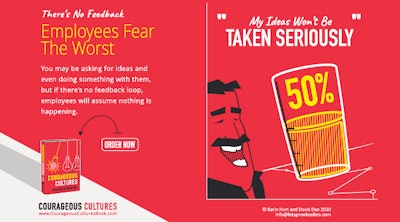
How often are your employees speaking up with creativity, empathy, and problem solving?
In too many manufacturing businesses, the answer is “not nearly enough.”
The automation revolution continues to change the nature of manufacturing, but the secret to surviving and thriving in the automation revolution is in what computers can’t replace: human creativity, empathy, and critical thinking.
Leading in the automation revolution isn’t about what you can control; it’s about what your people can create and contribute.
Asking Isn’t Enough
We were working with a large organization that had done an excellent job of asking every employee for their suggestions. They regularly asked people at every level of the organization for their ideas, suggestions for innovation, and solutions. They had a robust system where people submitted hundreds of suggestions every month.
As we talked with Adam, a senior executive about how they used the system, he made an interesting observation: “About half the suggestions we get are ideas that have already been implemented—or are underway.”
“That’s great,” we said. “People must feel good about how they’re making a difference”
He frowned. “Well, not exactly. Our surveys still show people feeling like their ideas aren’t valued.”
As we explored this gap, we asked, “How do you let people know what’s happened with their idea or that it’s already being used?”
He was quiet for a moment. “We aren’t.” And then a rueful grin. “No wonder people don’t feel appreciated for their ideas.”
In our research for Courageous Cultures, we found that half of the respondents, irrespective of their level in the organization, felt that their leaders don’t take their ideas seriously.
But from our conversations with executives and senior leaders across a range of industries, we know that innovation and solutions aren’t just appreciated—they’re vital.
Frequently, the gap comes down to how you respond. You may appreciate the many ideas and ways people are thinking about how to be better, but if you never circle back and let them know, they feel ignored.
They’ll assume you don’t value their contributions, don’t take their ideas seriously, and are stuck in your ways.
But you can easily change this dynamic and maintain a steady flow of innovation and solutions when you Respond with Regard.
Respond with regard means that when you receive an idea, you react with gratitude, information, and invitation:
- Gratitude that they cared and took the time to think about how to make things better
- Information about their idea
- Invitation to continue thinking, solving, and suggesting
Respond with Regard
Here’s how responding with regard looks in practice with different types of ideas you might receive:
1. The idea is already being used, or implementation is underway.
Gratitude: “I appreciate you thinking about how we can improve.”
Information: “That was a great idea and we’re already doing it. Here’s where you can learn more …”
Invitation: “I’d love to hear your ideas on how can solve … (a significant challenge).”
2. The idea is half-baked or is incomplete.
Gratitude: “Thank you for taking the time to share this.”
Information: “I wanted to give you some additional information that might help as you’re thinking about these issues.”
Invitation: “I’d love to hear your thoughts on how we might get the outcome you suggested in light of this added information.”
3. The idea is ready to go to trial or testing.
Gratitude: “Really appreciate you thinking this through.”
Information: “Your idea is ready for a test run. Here’s how you can get involved.”
Invitation: “As you’re working on that, I’d love to hear your thoughts on how it might help us solve …(a significant strategic goal or challenge).”
4. The idea isn’t useful now.
Gratitude: “Thank you for thinking about how we can be more effective here.”
Information: “This is a great idea to diversify our customer base. Right now, however, our top priority is improving our existing customer experience and that’s where we’re putting time and money.”
Invitation: “I would love to get your ideas about how we could improve our customer experience.”
When you respond with gratitude, information, and invitation, people know that you value their contributions and they’re much more likely to continue thinking and speaking up with the thoughtful innovation and solutions that you need to be competitive.
Karin Hurt and David Dye are the founders of Let’s Grow Leaders, an international leadership development and training firm and the authors of Courageous Cultures: How to Build Teams of Micro-Innovators, Problem Solvers, and Customer Advocates (Harper Collins, July 2020).
























